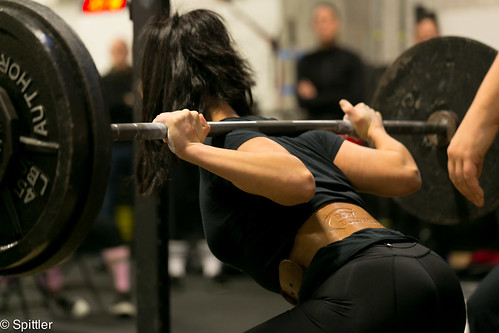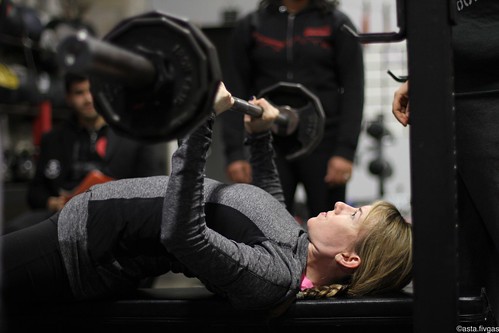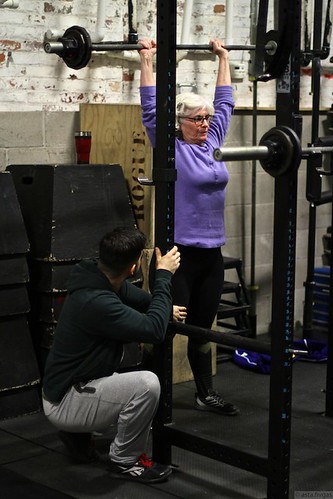Failing, Bailing, and Training Culture at CrossFit Affiliates
 Monday, March 10, 2014 at 12:00AM
Monday, March 10, 2014 at 12:00AM 
At CFSBK, we discourage members from failing slow lifts—squats, presses, and deadlifts—on a regular basis. Of course, failing is an inevitable part of training for experienced CrossFitters, since we want to push our limits and really discern our capacity. But the key is that it’s inevitable for experienced CrossFitters. We particularly encourage new members at CFSBK not to hit failure on their lifts for at least four to six months of consistent training, since they don’t have a solid enough foundation to be working with training maxes. In this week’s article, we'll talk about hitting failure on lifts and how it relates to gym culture, safety, and training appropriateness.
How an affiliate handles and teaches failing is usually related directly to the intentionality of the programming and the overall culture of how to train well. For more information about our programming, check out our previous articles “Effective Programming Strategies at CrossFit Affiliates” and "The Benefits of Leveled Programming," which address how we program and offer our members different options based on training age and goals. In this article, I want to focus more on how failing should happen only within certain programming contexts.
Training Versus Testing, and Its Impact on Gym Culture
Failing lifts too often can be seriously taxing on the central nervous system and frustrating for athletes—in addition, it adds psychological stress and creates negative expectations when approaching lifts. To prevent it from occurring too often and to gain control over teaching our athletes to fail well, CFSBK works testing our lifts into our programming macro cycles. For more experienced members, testing new rep maxes at the end of our cycles is an acceptable and inevitable part of serious training. But every day is not a limit test and we don't want anyone maxing out to failure with any regularity. Our day-in, day-out workouts should be considered training, and an opportunity to go a little bit heavier or hit prescribed percentages without reaching absolute limits.
 Teaching the difference between training and testing significantly impacts the culture of your gym, since training intelligently enables athletes to learn when to push through a difficulty instead of giving up. If an athlete is trained to think, "Okay, when things get hard, I've got an easy escape route in bailing," they learn to give up more often and expect missed reps to be a regular part of their training routine. Missed reps should be meaningful as an indicator of one’s current capacity, not simply the norm. When missing reps and failing become the norm, the experience can subtly undermine an athlete’s self-expectations and the mindset with which they approach their lifts.
Teaching the difference between training and testing significantly impacts the culture of your gym, since training intelligently enables athletes to learn when to push through a difficulty instead of giving up. If an athlete is trained to think, "Okay, when things get hard, I've got an easy escape route in bailing," they learn to give up more often and expect missed reps to be a regular part of their training routine. Missed reps should be meaningful as an indicator of one’s current capacity, not simply the norm. When missing reps and failing become the norm, the experience can subtly undermine an athlete’s self-expectations and the mindset with which they approach their lifts.
Teach your advanced members to respect heavy weight, and teach them that when it comes time to work, they should grind. Of course it should feel difficult and it should feel heavy! They should expect to fight for lifts! But just like in real life, you don't start fights you don't think you can win—especially on a regular basis. A skilled athlete doesn't need to constantly miss reps to know their potential on any given day. A mark of real skill and intelligence in training involves developing an innate sense of one’s capabilities, and knowing when to call it quits. Missed lifts should be considered learning experiences for an athlete’s physical capacity, psychological outlook, and technique, and they always should be put into the broader context of the intended training stimulus for that specific day.
 Why Novice Lifters Should Avoid Failing Lifts
Why Novice Lifters Should Avoid Failing Lifts
Having novice lifters attempt rep maxes on their lifts is both dangerous, inappropriate, and an ineffective use of their training time. All our new members start out with weights that feel "too light" and then they gradually add weight on a weekly basis and as their technique warrants (better technique equals more weight). Over time, they'll develop the requisite motor patterns, soft tissue integrity, and experience to handle heavier weights and test their limits. But before that, the proper foundation needs to be established. Remember, literally anything will "work" for untrained populations. You could have them squat on Day One, take a Zumba class on Day Two, run five miles on Day Three—and then a week later, test their squat and see some improvement. So the key is optimizing their novice training stage in a way that sets them up for long-term success.
Long-term success happens through progressive overload and good coaching. As coaches, we need to provide our athletes with the appropriate stimulus for their strength and experience, and most novice athletes have a pretty low baseline for what’s required to stimulate an adaptation. Having someone walk off the street and attempt a 1RM deadlift is well in excess of what they need to produce a meaningful adaptation. Why not have that 35-year-old mother of two with no deadlifting experience work up to 75lbs (which feels "light" to her) for a set of five and focus on being perfect at the movement. The next time she comes in, she can try 85lbs, and so on and so forth until she's gradually moving some significant weight with the confidence, experience, and consistent form that she needs to get stronger.
 Furthermore, asking someone who has barely mastered the air squat to get under a heavy bar will scare them off, and rightfully so. As coaches who have most likely been training for years, it can be easy to forget your initial experiences with pushing and pulling heavy weights, and how frightening it can be. Asking someone to do something difficult with heavy loads doesn’t necessarily make you a good coach—it makes you someone who owns weights. It’s important to see our training through a novice lens and empathize accordingly.
Furthermore, asking someone who has barely mastered the air squat to get under a heavy bar will scare them off, and rightfully so. As coaches who have most likely been training for years, it can be easy to forget your initial experiences with pushing and pulling heavy weights, and how frightening it can be. Asking someone to do something difficult with heavy loads doesn’t necessarily make you a good coach—it makes you someone who owns weights. It’s important to see our training through a novice lens and empathize accordingly.
If you’re not teaching your athletes through your programming how to train responsibly with longevity in mind, they won’t learn how to slowly approach gaining strength and competence with the required lifts. Start folks slow and let them know that just because they could go a little heavier today doesn’t mean it's optimal for them. If an athlete focuses on going a little heavier each week, they keep pushing the ceiling of their potential a little bit higher—instead of slamming into that ceiling and having nowhere to go but back down. When we see folks missing reps out of the programming context, it's time to pull them back and have a conversation about training versus testing.
How to Fail Well
Proper spotting and bailing techniques need to be taught and initially supervised—the same as anything else in your gym—so that when it comes time to test training, your athletes are prepared and safe. Spotting technique for the back squat and bench press can be found in Mark Rippetoe’s Starting Strength: Basic Barbell Training (Third Edition), pages 62-64 and 172-172 respectively. All other lifts require teaching proper bailing technique through demonstration and practice at sub-maximal weights. It's also the gym’s responsibility to make sure that if people are going to potentially miss reps, the area is clear of loose plates and other athletes that could make a good bail go bad.
 Conclusion
Conclusion
I was talking to a new affiliate owner a few years ago and he mentioned he gets really stressed during the lifting portions of group classes because he’s terrified one of his athletes will hurt themselves. During his classes, his athletes—regardless of their training experience—approached all lifting as max efforts. He felt like he was constantly running around just telling people what not to do. This was a well-intentioned, great athlete (who I know is now a great coach and has since found other strategies for managing his classes). But his situation at the time serves as a good reminder that being a great athlete doesn’t immediately lead to an awareness of what’s appropriate for the wide range of people that walk through your doors. The whole conversation about failing well circles back to cultivating this crucial skill of discernment as a coach. We have to learn to understand the needs of athletes at their various stages of development—and know when someone needs to temper their loads to be safe, and also when someone might need to put more weight on the bar to get better.

Reader Comments (3)
Lifting is a very dangerous practice for beginners and first-timers. One failure could make him regret for a lifetime. So proper training and supervision is really needed. Thanks to this!
Thanks for the comment, Romeo!
Great Post! As a newbie this post really helped not do overdo it, especially at the beginnnig and instead focusing on step-by-step improvements and keeping a quality in each movements and rep.